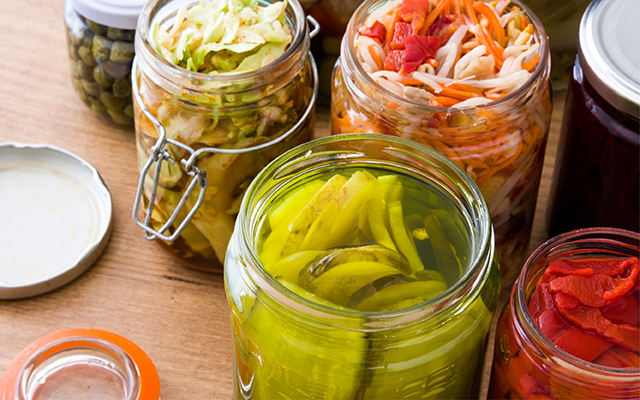Sara Jasper*, an aspiring Twin Cities painter, had always thought of herself as sickly. When she was a child, monthlong bouts of bronchitis kept her out of school. Her frequent nosebleeds were sometimes so severe that she woke up in a pool of blood. By the time Sara was 20, depression and an overwhelming fatigue were a part of her identity.
Then the fevers started. Once a month, Sara’s temperature would climb to as high as 105 degrees, leaving her so physically depleted that she routinely slept 14 to 16 hours a day. A college student in Wisconsin at the time, Sara was missing classes and growing increasingly anxious about her life.
Some doctors suspected a virus, some prescribed antibiotics, others implied a psychosomatic illness. When one doctor diagnosed her with a sexually transmitted disease, Sara broke down sobbing. “It was impossible. I was a virgin and had never been sexually active,” she says. “I was so frustrated and exhausted by all the misdiagnoses and misinformation that I called my mother and told her I couldn’t handle it anymore.”
A healthcare advocate, Sara’s mother had more resources available to her than the average concerned parent. She suggested that Sara move back to the Twin Cities to work with a preventive healthcare doctor, an MD who’d left a prior practice to spend more time with his patients. Sara’s new doctor gave her a two-hour assessment, asking her to fill out a booklet’s worth of personal health and history questions and to provide blood and stool samples.
One month later, the tests confirmed her doctor’s hunch: Sara appeared to be suffering from a serious overgrowth of Candida albicans, a yeastlike fungus that exists naturally inside every human body. Sara’s doctor explained that when a body is healthy, the immune system regulates candida growth. But if our immune system is compromised, candida can multiply unchecked, triggering a vicious cycle of symptoms and serious health problems.
At first, Sara didn’t understand what her doctor was describing, but a trip to the local bookstore told her that she wasn’t alone in her suffering. The titles were numerous: The Yeast Connection, The Yeast Syndrome, Candida-Related Complex, Chronic Candidiasis, The Candida-Yeast Syndrome. Although the books suggested divergent approaches to treating candida, all of the authors agreed that candida-related illnesses are very real, and quickly becoming a silent epidemic — one wreaking havoc with a startling percentage of the American population.
Mystery Malady
In 1978 George Kroker was an allergy fellow at a Chicago-area clinic. A conventionally trained MD, Kroker believed the best way to treat patients was to use tried and tested protocols. Then he found himself dealing with a complex set of allergy symptoms in a patient who wasn’t responding to conventional treatments.
When the patient left his clinic to pursue other forms of treatment, Dr. Kroker assumed that he’d never hear from her again. A few months later, she contacted him to report that a Birmingham, Ala., allergist named C. Orian Truss, MD, had successfully treated her allergies by controlling the level of candida in her body.
Kroker was curious enough about her treatment that he looked more closely into Dr. Truss’s theories. When another patient didn’t respond to conventional practices, he gave her Nystatin, an over-the-counter, antifungal medication.
Her symptoms improved, and Kroker decided it was time to seriously consider the role candida overgrowth was playing in his patients’ health.
In 1980, Truss, Kroker and a handful of other doctors met in Dallas to compare notes about the increasing number of patients they treated who were experiencing a seemingly incurable combination of headaches, fatigue, depression, irritability, digestive disorders, respiratory disorders, skin rashes, vaginal infections, and sensitivity to chemical odors and additives. “We all agreed that we were seeing the same kind of patients,” remembers Kroker, now an allergy specialist at Allergy Associates in La Crosse, Wis. “And that all of them responded to antifungal medicine.” They left the meeting convinced that an overgrowth of Candida albicans could be the key to many of their patients’ health problems.
One doctor at the meeting was William G. Crook, who surveyed his colleagues about their findings and used the results to write The Yeast Connection: A Medical Breakthrough. The book was a bestseller, and Crook, now deceased, became a national spokesman for the new disease, which is still a matter of considerable debate in medical circles today.
Yeasts and You
Yeasts are a part of our everyday lives. Inside our bodies, as many as 500 varieties of viral, bacterial and fungal microorganisms, including candida, exist.
Candida lives primarily in the mucous membranes of the mouth, intestinal tract, digestive tract and vagina. While vaginal candidiasis, oral thrush and yeast overgrowths such as diaper rash and jock itch are common medical conditions that all physicians agree should be treated, the idea that candida yeasts can also proliferate within the intestines and elsewhere in the body remains more controversial in conventional medical circles.
In The Yeast Connection, Crook insisted that an overgrowth of candida is at the root of many childhood ear infections, and attention and hyperactivity disorders, and that it may even play a role in autism.
Candida proliferation may also be a factor in many thyroid-related and autoimmune disorders, suggests Mary Shomon, a Washington, D.C.–based patient advocate and author of Living Well With Hypothyroidism: What Your Doctor Doesn’t Tell You That You Need to Know.
“What I’ve found is that candida weakens the immune system so that it isn’t able to fight off pathogens,” she says. In her research, Shomon has interviewed many doctors who report that when a person suffering from hypothyroidism or fibromyalgia is treated for candida, it is not unusual for many, if not all, of their symptoms to lessen or disappear. (Millions of people suffer thyroid problems without ever knowing why. Learn how to recognize and resolve thyroid dysfunction your doctor might miss at “Repair Your Thyroid“.)
“[Candida ] weakens the immune system so that it isn’t able to fight off pathogens.”
But not everyone is eager to acknowledge such connections. Much of mainstream medicine dismisses candida as a fad diagnosis — a one-size-fits-all solution to a wildly divergent set of health complaints.
“There is no scientific data to support that candida is related to these symptoms,” says Malcolm Blumenthal, MD, a professor of medicine and the director of the Asthma and Allergy Program at the University of Minnesota in Minneapolis. Yes, everyone’s body has candida, he says, but “everyone also breathes oxygen. And when people get sick, no one says that it’s due to the oxygen.”
Kroker says he is used to such skepticism. “Most doctors won’t treat a problem that lacks a proven method of diagnosis,” he says. “And the truth is that we aren’t entirely certain that candida is the crux of these health problems, even though we do know that they are yeast-related.”
Some critics cite admissions like Kroker’s as confirmation that a candida diagnosis is the ultimate in fuzzy science. But he rejects this notion: “No one is going to tell a breast cancer patient that they aren’t going to treat her cancer just because they don’t understand precisely how she got the disease. The way I see it, any physician faced with a condition for which there is no definitive diagnosis has two choices: You can ignore the problem, or, if there is a safe and promising trial cure, you can give that a try.”
Common Complaints
Some experts estimate that as much as 50 to 80 percent of the American population is suffering from a mild to severe candida-related illness. How does such a common organism make so many of us ill? According to Michael McNett, MD, the owner and medical director of Paragon Clinic, a Chicago-area clinic that specializes in treating fibromyalgia, when candida multiplies to high levels it also enters the bloodstream.
“Once that happens, your immune system has to develop an immunity to yeast in order to wipe it out of the bloodstream,” he says. “But once the immune system has been sensitized to yeast, it can tell when it is in the gut and will attack it in the intestines, too. In response, candida releases chemicals that are then absorbed by the body and make you sick.”
According to physicians who treat candida-related illnesses, the overuse of broad-spectrum antibiotics and steroid drugs in both medicine and agriculture is at least partially to blame for the modern proliferation of candida.
[The] overuse of broad-spectrum antibiotics and steroid drugs in both medicine and agriculture is at least partially to blame for the modern proliferation of candida.
Antibiotics are powerless against yeasts (antifungals are the only effective conventional medication); worse, the antibiotics wipe out the “friendly” bacteria that tend to keep yeast growth in check. Because antibiotics disrupt the body’s delicate balance of microorganisms, they also pave the way for opportunistic candida and other yeasts to multiply and circulate toxins throughout your body.
Oral contraceptives and pregnancy have been identified as having a probable role in promoting candida overgrowth, which can set in as the result of hormonal changes. Many doctors also suspect that overuse of nonsteroidal anti-inflammatories (NSAIDs) such as aspirin and ibuprofen can contribute to creating a candida-friendly environment. (See “This Is Your Body on Ibuprofen” for more.)
Other candida specialists blame candida overgrowth on diet — specifically, a standard American diet high in sugar and other simple carbohydrates and low in fiber, alkalinizing vegetables and complex carbohydrates.
Simple sugars are rapidly metabolized by yeasts; they also inhibit the growth of friendly bacteria, which further compromises the immune system. According to Crook, stress, diabetes and allergies can all increase a person’s susceptibility to a candida-related illness.
Kroker adds that people with mold allergies frequently have a cross-sensitivity to candida. Exposure to environmental toxins in food, air and water may also lower immunity and promote susceptibility to yeasts in general.
Difficult Diagnosis
Diagnosing a candida-related illness can be tricky. “Because we all have a certain amount of it in our bodies, you really can’t culture for it,” says Kroker.
The fact that different doctors use different testing methods only inflames conventional physicians’ skepticism about candida overgrowth as a bona fide health issue. Some doctors rely on blood tests, while others prefer stool tests to measure antibodies to the candida antigen.
A detailed medical history is the best way to determine whether candida overgrowth is a factor in a patient’s poor health.
Still others, Kroker included, believe that a detailed medical history is the best way to determine whether candida overgrowth is a factor in a patient’s poor health. “You look for susceptibility factors and load factors,” he says. “If a person has a family history of allergies and they are taking antibiotics, I want to look further.”
Almost every candida book includes a health questionnaire to help you determine whether or not a yeast overgrowth may be contributing to your health complaints. While these questionnaires are helpful, they are not conclusive. A high number of “yes” answers doesn’t mean you should immediately start treating yourself for candida overgrowth. Rather, this is an indication to seek out a healthcare practitioner who will consider yeast overgrowth as a possible factor in your health complaints.
In general, alternative health practitioners are more willing than conventionally trained physicians to consider that candida is a serious health concern. In anticipation of most MDs’ skepticism, The Yeast Connection (www.yeastconnection.com) Web site provides a downloadable physician’s packet that includes a letter for your doctor, a list of tests, a medical history form and a daily symptom chart. It also hosts an online discussion board, and facilitates support groups where you can exchange information and ask other candida sufferers in your area for referrals.
Fighting Fungus
Treating a candida-related illness is almost as controversial as the disease itself, since every expert has a different opinion about treatment. Most specialists agree that a phased approach is required in order to (a) starve and kill the yeast, (b) promote the growth of good bacteria, and (c) maintain an anti-candida lifestyle. But that’s where the agreement ends.
For every doctor who advocates a diet free of all sugars and starches, you’ll find an equal number who believe that it’s OK to eat potatoes or rice or some fruits. Elson Haas, MD, author of Staying Healthy With Nutrition, is among the many who stress healthy eating but who also use herbal supplements (see “Anti-Candida Supplements,” next page) and prescription-strength antifungal medications such as Nizoral and fluconazole to get yeast out of the body.
Prescription antifungals act quickly and effectively, but like most pharmaceuticals, they can also cause side effects. Because they do nothing to alter the underlying dietary and lifestyle conditions that encourage yeast overgrowth, they also provide no protection against recurrence.
One small study published in the 1995 Townsend Letter showed that Monistat, nystatin and fluconazole performed less well than natural supplements such as acidophilus and garlic in sustaining long-term improvement.
Because post-medication recurrence is common, most candida experts suggest that antifungal medications and supplements be viewed as only one component of a more holistic, longer-term strategy. That strategy includes reducing or temporarily eliminating certain foods and substances, and then following a rotation or maintenance plan once you begin reintroducing candida-fueling foods into your diet.
Following any serious anti-candida diet is hard work. It can also trigger intense cravings and new symptoms, especially when the yeasts start to die and decompose, releasing still more toxins into your body.
Crook’s The Yeast Connection Handbook stresses that every person is an individual and that there is no single magic solution that will cure everyone. Some people will find that they can tolerate cheese but not peanut butter. Others will react well to fruit but not breads.
Following any serious anti-candida diet is hard work. It can also trigger intense cravings and new symptoms, especially when the yeasts start to die and decompose, releasing still more toxins into your body.
Known as the “die-off effect” or “Herxheimer reaction,” this nasty flare-up can cause withdrawal-like cravings for sugars and carbs, a brief return of original symptoms, or a variety of immune-related maladies.
Known as the “die-off effect” or “Herxheimer reaction,” this nasty flare-up can cause withdrawal-like cravings for sugars and carbs, a brief return of original symptoms, or a variety of immune-related maladies.
The good news: The effect is only temporary and an indication that your treatment is doing its job. Die-off reactions can last from a few days to a few weeks, but most clear up in less than a week. Many experts suggest that drinking lots of pure water and increasing your intake of fiber-rich foods can help speed along the clearing and detoxification process. (Dietary fiber performs key roles that might surprise you, affecting everything from your skin to your gallbladder, heart and immunity. See “Fiber: Why it Matters More than You Think” for more).
Most experts suggest that people on an anti-candida diet should also take probiotics, such as acidophilus, which help recolonize and promote the growth of healthy bacteria. These healthy bacteria produce antimicrobial enzymes and natural antibiotics that retard candida growth.
So is all this work worth it? Sara Jasper hasn’t the smallest doubt. Five years after her debilitating bout with candida, she still leans away from sugar and wheat, but she no longer adheres to an overly restricted diet. Along with daily walks along the Mississippi River, Sara practices qigong to manage her stress and says she feels healthier than she has in her entire life.
“Sticking with the candida treatment was tough at first, but it paid off quickly, and on so many levels,” she says. “It helped me reclaim my physical health, but more important, it also helped me redefine myself as a healthy person — for the first time in my adult life, really. Getting free of all that physical misery changed my entire outlook, not just about health, but also my choices, my freedoms and my opportunities for happiness.”
*Not her real name
Anti-Candida Supplements
Naturopathic physicians use a variety of herbal and nutritional supplements to inhibit or treat candida and other fungus-related symptoms, most often in conjunction with prescription medications and dietary changes.
Typical protocols might include the following:
- Black walnut
- Caprylic acid
- Coconut oil
- Echinacea
- Deglycyrrhizinated licorice (DGL)
- Digestive enzyme supplements
- Garlic
- Glucosamine
- Grapefruit seed extract
- Molybdenum
- N-acetylglucosamine (NAG)
- Olive oil
- Pau d’Arco
- Probiotic supplements
- Psyllium husk and seed powder
As with all supplements and medications, check with your physician or healthcare provider to avoid undesirable sensitivities or drug interactions.
For more information and a detailed anti-candida protocol, see Conquering Yeast Infections: The Non-Drug Solution for Men and Women by S. Colet Lahoz, RN, MS, LAc.
Common Symptoms of Yeast/Fungus Overgrowth
- Skin problems: hives, scaling, athlete’s foot, jock itch, diaper rash, psoriasis, fungal nail infections
- Muscular and nervous problems: aches or swelling in muscles or joints, numbness, tingling, burning, weakness, paralysis
- Itchy ears and nose; increased sensitivity to smells and chemical additives
- Headaches, brain fog or inability to concentrate
- Gastrointestinal problems: constipation, abdominal pain, diarrhea, gas, bloating
- Oral thrush, sore or itchy throat
- Problems involving reproductive organs: PMS, urinary tract and vaginal infections, prostatitis, impotence
- Respiratory problems, congestion, fevers
- Depression, low-mood, fatigue or lethargy
Got Yeast?
Many candida specialists depend on questionnaires, such as the one below, to help patients identify symptoms that are potentially yeast-related. The following questionnaire is excerpted from The Yeast Connection, by William G. Crook, MD. A more detailed questionnaire can be found at www.yeastconnection.com.
- Have you taken repeated “rounds” of antibiotic drugs?
- Have you been troubled by premenstrual tension, abdominal pain, menstrual problems, vaginitis, prostatitis, or loss of sexual interest?
- Does exposure to tobacco, perfume and other chemical odors provoke moderate to severe symptoms?
- Do you crave sugar, breads or alcoholic beverages?
- Are you bothered by recurrent digestive symptoms?
- Are you bothered by fatigue, depression, poor memory or “nerves”?
- Are you bothered by hives, psoriasis, or other chronic skin rashes?
- Have you ever taken birth control pills?
- Are you bothered by headaches, muscle and joint pains, or incoordination?
- Do you feel bad all over, yet the cause hasn’t been found?
Scoring:
- If you have three or four “yes” answers, yeasts possibly play a role in causing your symptoms.
- If you have five or six “yes” answers, yeasts probably play a role in causing your symptoms.
- If you have seven or more “yes” answers, your symptoms are almost certainly yeast-connected.
Copyright 1983, William G. Crook, MD
This article originally appeared in the January/February 2004 issue of Experience Life.




This Post Has 0 Comments